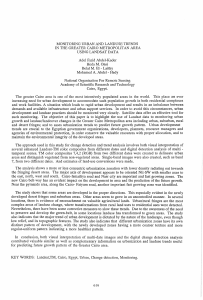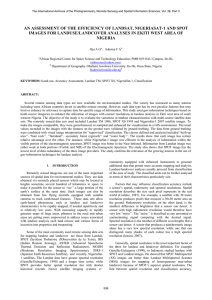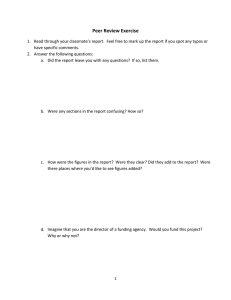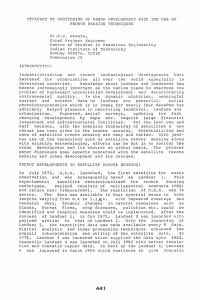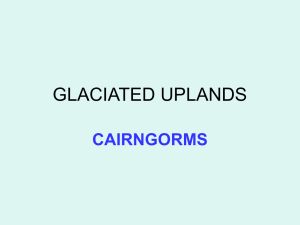AN ASSESSMENT OF THE EFFICIENCY OF LANDSAT, NIGERIASAT-1 AND SPOT
advertisement
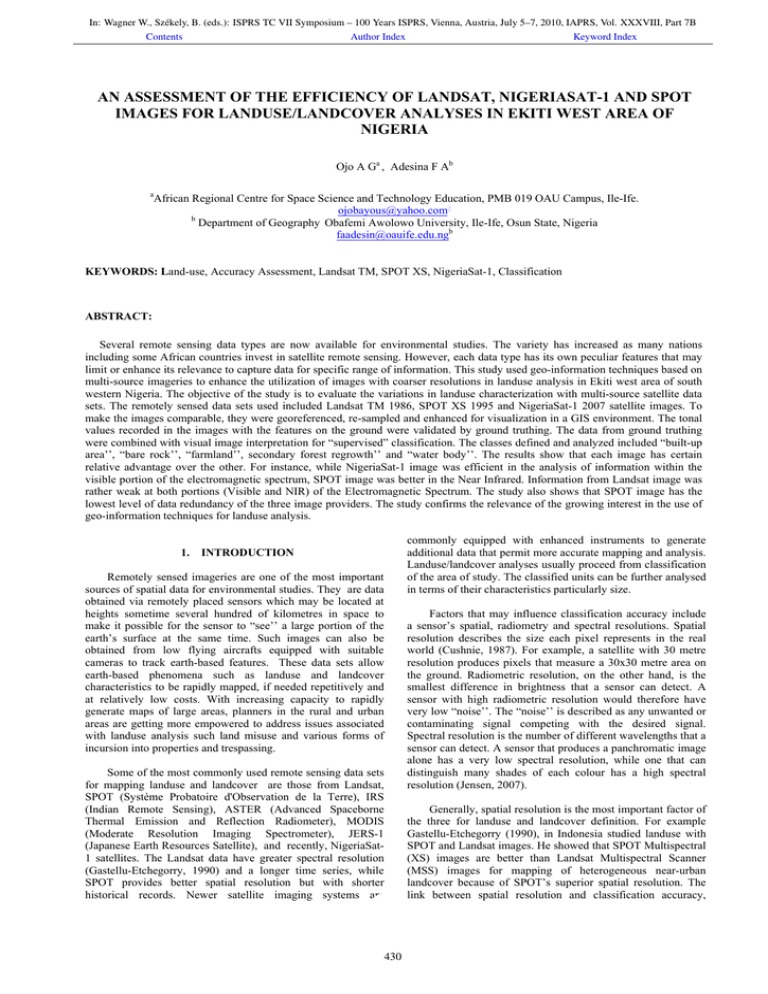
In: Wagner W., Székely, B. (eds.): ISPRS TC VII Symposium – 100 Years ISPRS, Vienna, Austria, July 5–7, 2010, IAPRS, Vol. XXXVIII, Part 7B Contents Author Index Keyword Index AN ASSESSMENT OF THE EFFICIENCY OF LANDSAT, NIGERIASAT-1 AND SPOT IMAGES FOR LANDUSE/LANDCOVER ANALYSES IN EKITI WEST AREA OF NIGERIA Ojo A Ga , Adesina F Ab a African Regional Centre for Space Science and Technology Education, PMB 019 OAU Campus, Ile-Ife. ojobayous@yahoo.coma b Department of Geography Obafemi Awolowo University, Ile-Ife, Osun State, Nigeria faadesin@oauife.edu.ngb KEYWORDS: Land-use, Accuracy Assessment, Landsat TM, SPOT XS, NigeriaSat-1, Classification ABSTRACT: Several remote sensing data types are now available for environmental studies. The variety has increased as many nations including some African countries invest in satellite remote sensing. However, each data type has its own peculiar features that may limit or enhance its relevance to capture data for specific range of information. This study used geo-information techniques based on multi-source imageries to enhance the utilization of images with coarser resolutions in landuse analysis in Ekiti west area of south western Nigeria. The objective of the study is to evaluate the variations in landuse characterization with multi-source satellite data sets. The remotely sensed data sets used included Landsat TM 1986, SPOT XS 1995 and NigeriaSat-1 2007 satellite images. To make the images comparable, they were georeferenced, re-sampled and enhanced for visualization in a GIS environment. The tonal values recorded in the images with the features on the ground were validated by ground truthing. The data from ground truthing were combined with visual image interpretation for “supervised” classification. The classes defined and analyzed included “built-up area’’, “bare rock’’, “farmland’’, secondary forest regrowth’’ and “water body’’. The results show that each image has certain relative advantage over the other. For instance, while NigeriaSat-1 image was efficient in the analysis of information within the visible portion of the electromagnetic spectrum, SPOT image was better in the Near Infrared. Information from Landsat image was rather weak at both portions (Visible and NIR) of the Electromagnetic Spectrum. The study also shows that SPOT image has the lowest level of data redundancy of the three image providers. The study confirms the relevance of the growing interest in the use of geo-information techniques for landuse analysis. 1. commonly equipped with enhanced instruments to generate additional data that permit more accurate mapping and analysis. Landuse/landcover analyses usually proceed from classification of the area of study. The classified units can be further analysed in terms of their characteristics particularly size. INTRODUCTION Remotely sensed imageries are one of the most important sources of spatial data for environmental studies. They are data obtained via remotely placed sensors which may be located at heights sometime several hundred of kilometres in space to make it possible for the sensor to “see’’ a large portion of the earth’s surface at the same time. Such images can also be obtained from low flying aircrafts equipped with suitable cameras to track earth-based features. These data sets allow earth-based phenomena such as landuse and landcover characteristics to be rapidly mapped, if needed repetitively and at relatively low costs. With increasing capacity to rapidly generate maps of large areas, planners in the rural and urban areas are getting more empowered to address issues associated with landuse analysis such land misuse and various forms of incursion into properties and trespassing. Factors that may influence classification accuracy include a sensor’s spatial, radiometry and spectral resolutions. Spatial resolution describes the size each pixel represents in the real world (Cushnie, 1987). For example, a satellite with 30 metre resolution produces pixels that measure a 30x30 metre area on the ground. Radiometric resolution, on the other hand, is the smallest difference in brightness that a sensor can detect. A sensor with high radiometric resolution would therefore have very low “noise’’. The “noise’’ is described as any unwanted or contaminating signal competing with the desired signal. Spectral resolution is the number of different wavelengths that a sensor can detect. A sensor that produces a panchromatic image alone has a very low spectral resolution, while one that can distinguish many shades of each colour has a high spectral resolution (Jensen, 2007). Some of the most commonly used remote sensing data sets for mapping landuse and landcover are those from Landsat, SPOT (Système Probatoire d'Observation de la Terre), IRS (Indian Remote Sensing), ASTER (Advanced Spaceborne Thermal Emission and Reflection Radiometer), MODIS (Moderate Resolution Imaging Spectrometer), JERS-1 (Japanese Earth Resources Satellite), and recently, NigeriaSat1 satellites. The Landsat data have greater spectral resolution (Gastellu-Etchegorry, 1990) and a longer time series, while SPOT provides better spatial resolution but with shorter historical records. Newer satellite imaging systems are Generally, spatial resolution is the most important factor of the three for landuse and landcover definition. For example Gastellu-Etchegorry (1990), in Indonesia studied landuse with SPOT and Landsat images. He showed that SPOT Multispectral (XS) images are better than Landsat Multispectral Scanner (MSS) images for mapping of heterogeneous near-urban landcover because of SPOT’s superior spatial resolution. The link between spatial resolution and classification accuracy, 430 In: Wagner W., Székely, B. (eds.): ISPRS TC VII Symposium – 100 Years ISPRS, Vienna, Austria, July 5–7, 2010, IAPRS, Vol. XXXVIII, Part 7B Contents Author Index however, is sometimes weak (Jensen, 2005). In heterogeneous areas, such as residential areas, it has been shown that classification accuracies may improve even as spatial resolution decreases (Cushnie, 1987). This occurs due to the potentials of urban features to blend together to form composite distinctive “urban signals” that can be distinguished from other landcovers. In this study, the capabilities of three satellite imageries including Landsat, NigeriaSat-1 and SPOT-XS for landuse studies are evaluated with a view to amplifying the understanding of their specific potentials, advantages and limitations for environmental studies. This is borne out of the growing recognition of the need to develop “appropriate technology” for developing countries to enable researchers based in these countries to accomplish desirable level of sophistication in earth’s resources analyses even with their limited access to spatial data. 2. THE STUDY AREA/ LOCATION EXTENT The study area is made up of Ekiti west, Ado-Ekiti, Irepodun/ Ifelodun and Ekiti south-west. Local government areas in Ekiti State of western Nigeria (Figure1). The State lies within Longitudes 4o 5’ and 5o 45’ East of the Greenwich Meridian and Latitudes 7o 15’ and 8o 5’ North of the Equator. It is about 6,353 square kilometers in size. It is bounded in the north by Kwara and Kogi States, in the West by Osun State and Ondo State in the East and in the South. The State has 16 Local Government Areas. By 1991 Census, its population was 1,647,822. The estimated population upon its creation on October 1st 1996 was 1,750,000 with the capital located at AdoEkiti (Ekiti Investors Handbook, 2002). The current estimated population based on 2006 census, was 2384212 million people (NPC, 2006). Keyword Index (November-March) seasons with an annual rainfall of around 1150mm. Temperatures range between 21o and 28oC with high humidity. The South-Westerly wind and the North-Easterly Trade winds blow in the rainy and dry (harmattan) season respectively. The tropical forest originally covered this part of Nigeria. However, as a result of exploitation for many centuries of exploitation, the original vegetation has been removed and now replaced with anthropic covers. Forest is now confined largely in the south, while savanna dominates the natural landscape in the north (Kayode, 1999 and EKSG, 1997). 3. 3.1 METHODOLOGY Data Acquisition and Image Preprocessing Relevant data were collected on the physical attributes of the five landuse types, i.e. farmland, built-up areas, forest regrowth, bare lands and water bodies, which were the dominant landuse in the area. Sample sites for data collection were determined from the remotely sensed imageries .For each landuse, five sample sites measuring 100 x 100m were selected and were fully described during field observations, variables examined for site characterization included dominant, concrete among others and drainage characteristics of the site . The coordinates of the sample sites were tracked with Global Positioning System (GPS) receiver. Secondary data used were Landsat TM, SPOT- XS NigeriaSat-1 covering the study area. Table1 shows key parameters of the data used for the study. Images were obtained from the National Centre for Remote Sensing Jos, Forest Monitoring, Evaluation and Coordinating Unit (FORMECU) Abuja and Global Land Cover Facility (GLCF) an Earth Science Data Interface. The topographic map covering the study area was collected from the Ministry of Land and Surveys, Lagos. The satellite data were extracted one after the other as subscenes from the original datasets. For the purpose of landuse/cover assessment, a common window covering the same geographical coordinates of the study area was extracted from the scene of the images obtained. This made the band Red, Blue, Green (RGB-123) colour combination. For SPOT XS data, Channel 3 was assigned red plane, Channel 2 to green and channel 1 to blue plane. The band combination then consisted of Blue, Green and Red (BGR-321) colour combination. For NigeriaSat_1 data set, colour combination, channel 1 was assigned to red plane, channel 2 to green plane and 3 to blue plane. This puts the band combination as Red, Green and Blue (RGB-123). Figure 1: Map of Ekiti State and the LGAs used for the study The State is mainly an upland area, rising generally around 250 meters above the sea level (Ekiti Investors Handbook, 2002). The landscape consists of ancient plains broken by steep-sided outcropping dome rocks. These rocks occur singly or in groups or ridges and the most notable of these are to be found in Efon-Alaaye, Ikere-Ekiti and Okemesi-Ekiti (EKSG, 1997). The area is underlain by metamorphic rock of the basement complex. The State is dotted with hills of varying heights. The notable ones among them are Ikere-Ekiti Hills in the southern, Efon-Alaaye Hills in the western and Ado-Ekiti Hills in the central parts. The State enjoys the tropical climate with two distinct seasons. These are the rainy (April-October) and the dry 431 The geometric errors were corrected using ground control points (GCP). The process of georeferencing in this study started with the identification of features on the image data, which can be clearly recognized on the topographical map of the study area and whose geographical locations were clearly defined. Stream intersections and the intersection of the highways were used as ground control points (GCP). The latitude and longitude of the GCPs of clearly seen features obtained in the base map were used to register the coordinates of the image data used for the study. All the images were georeferenced to Universal Transverse Mercator projection of WGS84 coordinate system, zone 31N with Clarke 1866 Spheroid. Nearest-neighbor re-sampling method was used to correct the data geometrically. In: Wagner W., Székely, B. (eds.): ISPRS TC VII Symposium – 100 Years ISPRS, Vienna, Austria, July 5–7, 2010, IAPRS, Vol. XXXVIII, Part 7B Contents Author Index 1 Attributes of the images Image Table. Source Sen Acquisitio B Name sor n Date an d Topograp hic Map Landuse Map Land sat TM SPOT NigeriaSa t-1 3.2 MLSL Lagos NCRS, Jos GLCF FORM ECU, Abuja NCRS, Jos - used Study Resolfor the Spectral ution Range (um) Area (km2 ) 1966 - - - - 1995 - - - - TM 1986 30m 0.45-0.90 MS S 1995 17 13 10m 0.45-0.69 185 x185 60x 80 Ima ger 2007 32m 0.52-0.90 13 600x 580 Landuse Classes Based on the knowledge of the study area, reconnaissance survey and additional information from previous studies in area, a classification scheme was developed after Anderson et al., (1976). The scheme gives a broad classification where each of the land use/ land cover was identified by a class (Table 2). These classes are apriori well defined on the three images used for the study. Bare soil, bare land Farm Land Shrubs, fallow, cropped land. Secondary forest Water Body 3.3 represent various land use classes of interest. The study engaged in ground truthing to the four Local Government Area of the study area. These are Ekiti west, Ado-Ekiti, Irepodun/ Ifelodun and Ekiti south-west Local government areas in Ekiti State (Figure1). Before the ground truthing, map of the study area was printed and was used as guide to locate and identify features both on ground and on the image data. The geographical locations of the identified features on the ground were clearly defined. These were used as training samples for supervised classification of the remotely sensed images. Five categories of land uses and land covers were clearly identified during ground truthing. These are secondary re-growth forest, water body, bare rocks, built-up areas and farm land. The processed images were subject to band correlation analysis to assess the nature and strength of the relationship among the bands in the imageries. 4 4.1 RESULTS Comparison of Basic Features among the Three Sensor Data Table 3 summarizes the correlation analysis of bands with each other within each of the three sensors. In the NigeriaSat-1 image, the Near-Infrared (NIR) band was negatively correlated with the visible bands (Green and Red) (-0.16, ≤ r ≥ -0.04; p < 0.05). In the Landsat TM image, the NIR band positively correlated with visible bands (0.02 ≤ r ≥ 0.22; p < 0.05). For the SPOT image, the NIR band also positively correlated with the visible bands (0.53 ≤ r ≥ 0.63; p < 0.05). The relationship between the visible bands were strongest in SPOT (r = 0.98), relatively strong in NigeriaSat-1 images (r = 0.53) and relatively low in Landsat TM (r = 0.22). Table. 2 Landuse classification scheme (after Anderson et al 1976) DESCRIPTION OF THE LANDUSE/LANDCOVE CATEGORIES LANDUSE/LANDCOVER Built-up Area Roads, buildings, open spaces Bare Rock Keyword Index Agro forest, riparian forest, advanced bush re-growth Dam, rivers streams. Table. 3 Correlation matrix analysis results for the three sens data Sensor Bands Green Red NIR Landsat Green 1.00 0.22 0.02 Red 0.22 1.00 0.93 NIR 0.02 0.22 1.00 NigeriaSat-1 Green 1.00 0.95 -0.04 Red 0.95 1.00 -0.16 LandCover/ Landuse Analysis For Landuse/Landcover analyses, the satellite images were classified using the supervised classification method. The combined processes of visual image interpretation of tones/colours, patterns, shape, size, and texture of the imageries and digital image processing were used to identify homogeneous groups of pixels, which represent various land use classes already defined. This process is commonly referred to as “training’’ sites because the spectral characteristics of those known areas are used to “train’’ the classification algorithm for eventual land use/ cover mapping of the remaining parts of the images. SPOT NIR -0.04 -0.16 1.00 Green 1.00 0.98 0.63 Red 0.53 1.00 0.98 NIR 0.63 0.53 1.00 Level of significance (p) <0.05 A Map of the study area was produced and was used to locate and identify features both on ground and on the image data. The geographical locations of the identified features on the ground were clearly defined. These were used as training samples for supervised classification of the remotely sensed images. The five categories of land uses/ land covers were clearly identified during ground truthing. Locations were tracked with the GPS to facilitate transference of the field information onto the images. 3.4 The results imply that the SPOT image is likely preferable to either of the other image types for the study of earth base features at the Visible and Near Infrared portions of the Electromagnetic Spectrum. On the other hand, NigeriaSat-1 imageries could give better information at the visible portion while Landsat imageries could be better in the Visible and Near Infrared portions of the spectrum. The results indicate that the strength of the correlation among the bands increases with increase in the spectral resolution of the imageries. This corresponds with what many authors have observed. For example, Kuplich et al. (2000) have suggested based on their studies, that high correlation between spectral bands is indicative of high degree of information. Spectrally adjacent bands in a multispectral remotely sensed image are often highly correlated. Multiband visible/near-infrared images of landuse areas will show negative correlations between the near-infrared Classification In this study, the satellite images were classified using supervised classification method. The combined process of visual image interpretation of tones/colours, patterns, shape, size, and texture of the imageries and digital image processing were used to identify homogeneous groups of pixels, which 432 In: Wagner W., Székely, B. (eds.): ISPRS TC VII Symposium – 100 Years ISPRS, Vienna, Austria, July 5–7, 2010, IAPRS, Vol. XXXVIII, Part 7B Contents Author Index TABLE. 4 ACCURACY ASSESSMENT OF LANDSAT TM IMAGERY and visible red bands and positive correlations among the visible bands because the spectral characteristics of land use are such that as the vigour or tone of the feature increases, the red reflectance diminishes and the near-infrared reflectance increases. 4.2 Keyword Index Landuse Classes Table 4, 5, and 6 contain summaries of the results accuracy assessment generated from the three images on the five land use. The overall, user as well as producer accuracies of individual classes were consistently high for the three imageries. The accuracies for Landsat, NigeriaSat-1 and SPOT were 66.5%, 81.2% and 82.8% respectively. The Kappa statistics were 0.87, 0.97 and 0.89 respectively. The user and producer accuracies of individual classes in Landsat ranged from 51.9% to 87.3%, whereas in NigeriaSat-1, they varied from 60% to 97.3% and in SPOT from 74.7% to 89%. On Landsat image for the ‘built-up area’ category of land use, the producer accuracy is 82.8% and the user is 87.3%. This means that more than 80% of the built-up area in the image was correctly defined and mapped. The other four land use classes i.e. bare rocks, farm land; secondary forest regrowth forest and water body had relatively low producer and user accuracies. For instance secondary forest regrowth has a producer accuracy of 66.5% and user accuracy of 51.9%. The four categories are thus not as well defined as the built-up areas. The ‘built-up area’ of NigeriaSat-1 had the highest accuracy on producer accuracy (97.3%), it also had user accuracy of 96.9%. On the SPOT image, the statistics on built-up area category are 81.98% for producer accuracy and 91.58% for user accuracy. Sat ellit e Ima ge Cla ssifi ed Data Lan dsat Buil t-up Area Bar e rock Far mlan d Sec. fores t regrow th Wat er body Reference Data UA % Kappa Re f. To tal s Cl ass To tal s Nu mb er Cor rect % PA % 0.6 7 10 0 94. 88 82. 79 82. 79 87. 26 1.00 00 8.2 1 4.5 2 10 0 91. 96 58. 84 58. 84 63. 98 1.00 00 52. 15 12. 29 0.9 0 10 0 91. 50 52. 15 52. 15 56. 99 1.00 00 9.4 1 29. 21 66. 49 21. 14 10 0 128. 04 66. 49 66. 49 51. 93 0.86 01 8.0 2 1.8 4 11. 87 72. 76 10 0 94. 64 72. 76 72. 76 76. 89 1.00 00 Bu iltup Ar ea % Ba re Ro ck % Fa rm lan d % 82. 79 5.6 0 4.6 7 Se c. Fo res t % 1.1 5 8.2 6 58. 84 12. 13 7.0 2 19. 14 1.7 9 0.1 5 Wa terbod y % Overall Landsat Classification Accuracy = 66.47% (i.e. 82.79+58.84+52.15+66.49+72.76 ), Overall Kappa Statistics = 0.8714 501.02 TABLE. 5 ACCURACY ASSESSMENT OF NIGERIA SAT-1 IMAGERY Satellite Image Cl ass ifie d Da ta Reference Data Buil t-up Are a % B ar e R oc k % F a r m la n d % Sec . Fo res t % Nigeriasa t-1 Bu 3. 0. 0.0 97.3 ilt03 0 5 2 up 2 Ar ea Ba 1.89 0. 3.0 77 re 2 9 .2 roc 3 7 k Far 002 0. 12. 8 m 39 12 8. lan 0 d 7 Se 0.04 7. 1 82. c. 64 1. 38 for 3 est 7 regro wt h Wa 0.73 11 0. 2.3 ter .6 3 7 bo 7 1 dy Overall NgeriaSat-1 Classification Accuracy = Overall KappaStatistics = 0.9712 It appears that Landsat has lower value for accuracies than either SPOT or NigeriaSat-1. Different reasons may be responsible for this outcome. One reason may have to do with the intrinsic characteristics of the images. For instance Landsat has a spatial resolution of 30metres, NigeriaSat-1 32 metres and the SPOT 10metres. Chen, et al., (2004) has shown that these can variously have effect on the levels of accuracies obtained from the images. Another reason could be that, spectral characteristics among the different land cover types (e.g. builtup, bare rock) are similar, while spectral variation within the same land cover type or even within the same image might be high (Cushine, 1987). R ef. T ot al s Cl ass To tal s Nu mbe r Cor rect % PA % UA % Ka pp a 10 0 10 0.4 2 97.3 2 97. 32 96. 91 1.0 000 3 5. 0 7 0. 0 0 10 0 11 7.5 5 77.2 7 77. 27 65. 73 1.0 000 10 0 10 0.6 0 88.0 7 88. 07 87. 55 1.0 000 3. 7 7 10 0 10 5.2 0 82.3 8 82. 38 78. 31 0.9 230 10 75. 60.0 60. 79. 6 0 08 0 00 92 0. 0 0 81.20% (i.e. 97.32+77.27+88.07+82.38+60.00 ), 1.0 000 W at er b o d y % 1. 1 6 498,85 TABLE . 6 ACCURACY ASSESSMENT OF SPOT IMAGERY Satellit e Image SPOT Referen Ref. Total s Classifie d Data Class Total s Numbe r Correc t % 89.52 81.98 PA % UA % Kappa 81.9 8 91.5 8 1.0000 Built-up Area Bui ltup Are a % 81.9 8 Bare rock 11.1 5 88.99 2.17 4.26 3.91 100 110.48 88.99 88.9 9 80.5 5 1.0000 Farmland 5.72 2.10 83.40 4.98 3.91 100 100.11 83.40 83.4 0 83.3 1 0.8681 Sec. forest regrowth 1.05 3.27 11.19 78.11 10.94 100 104.56 78.11 78.1 1 74.7 0 0.8714 Water body 0.10 0.98 0.37 12.62 81.25 100 95.32 81.5 0 85.5 0 0.9781 Bare Rock % Farm land % Sec. Fores t % Waterbody % 4.65 2.86 0.03 0.00 100 81.50 Overall Spot Classification Accuracy = 82.75% (i.e. 81.98+88.99+83.40+78.11+81.25 ), Overall Kappa Statistics = 0.8718 499.99 Fig2: Classified print of the Landsat TM image 433 In: Wagner W., Székely, B. (eds.): ISPRS TC VII Symposium – 100 Years ISPRS, Vienna, Austria, July 5–7, 2010, IAPRS, Vol. XXXVIII, Part 7B Contents Author Index Keyword Index 25000 20000 15000 10000 5000 0 Built-Up Bare Rock Farmland Landsat TM Fig3: Classified print of the NigeriaSat-1 image Nigersat-1 Sec Forest Water Body Spot Figure . 5 Histogram showing the three imageries with their respective landuses types. 4.4. Discussion: Variation in land use characterization and Accuracy The most basic output in remote sensing applications to landuse/landcover studies is land use characterization. This is information about the sizes of various landuse. When such information is available over a long period of time, it allows an assessment of landuse dynamics. Such characterizations are invaluable for the monitoring and managing of land resources and are increasingly vital for natural and regional development in Africa. Fig4: Classified print of the SPOT image The SPOT image had been rectified but was resampled to 32m in order to have the three imageries in the same spatial resolution. 4.3 Landuse characterization has been most used particularly in the developing countries, (Adesina and Amamoo 1994; Oyinloye and Adesina 2006). Differences in the spatial and spectral characteristics of features make a differentiation of landuse/landcover types possible. As a result of fundamental differences in the characteristics of the images used for this research, the study has proceeded with the assumptions that land use characterization will some how be different from one image to the other. Thus, SPOT, because of its higher resolution, would be more able to capture information than the two others. Also, Landsat would generate more details than NigeriaSat-1. In general, the point raised above was demonstrated in this study. For example SPOT image had higher correlation of important wave bands with each other than both Landsat and NigeriaSat-1. This implies that, SPOT captures more information than either of Landsat and NigeriaSat-1. Also with respect to landuse recognition, built-up areas were more efficiently identified and defined on the SPOT image than on the two others. However, the three satellite images were relatively inefficient in defining the other land use categories. It appears from the results that the superiority of enhanced spatial resolution declines with the size of the land use category to be defined. Land use characterization of the study Table 4.3 Shows the area covered in hectares, by the five landuse classes’ namely built-up areas, bare rocks, farmland and secondary forest regrowth and water body. On the Landsat image, “built-up area’’ covered 4,388.15 hectares which represented 9.6% of the total area of land under study. “Bare rock’’ covered 8,925.8 hectares (19.4%); “farmland’’ 9,461.96 hectares (20.6%); “secondary forest regrowth’’ 19,881.9 hectares (43.3%) and water body 3,241.56 hectares (7.1%). On NigeriaSat-1, “built-up area’’ covered an area of 4,547.69 hectares which represented 10% of the total land area under study. “Bare rock” was 8,016.2 hectares (18%) “farmland” 6,682.6 hectares (15%); “secondary forest regrowth’’ 23,266.60 hectares (52%) and “water body’’ 2,326.32 hectares (5%). With respect to SPOT image, “built-up area’’ covered 4,891.85 hectares which was 12% of the total land area under study. “Bare rock’’ was 12,887.70 hectares (30%); “farmland” 7,565.11 hectares (18%), “secondary forest regrowth’’ 14,665.7 hectares (34%) and “water body’’ covered 2,642.84 hectares (6%). In general, the land cover characterizations of the three imageries are over comparable area cover, despite the differences in the spatial resolutions of the images. “Secondary forest regrowth’’ is the largest in the three images and farmlands are comparable in size. The main difference is with respect to bare rock which was shown to cover a larger area in SPOT. The difference may be related to the time of imaging. Images taken in dry seasons would reveal more bare surfaces than those taken in the wet season. Table. 7 Areas of Landuse categories on the image 434 LANUSE/LAND COVER CATEGORIES LANDSAT AREA (Ha) AREA % NIGERIASAT-1 AREA AREA (Ha) % SPOT AREA (Ha) AREA % BUILT-UP AREA 4388.15 9.56 4547.69 10.14 4891.85 11.47 BARE ROCK 8925.80 19.44 8016.18 17.88 12887.70 30.22 17.74 FARM LAND 9461.96 20.62 6682.62 14.90 7565.11 SEC. FOREST REGROWTH WATER BODY 19881.90 43.31 23266.60 51.89 14665.70 34.38 3241.56 7.07 2326.32 5.19 2642.84 6.20 TOTAL 45899.37 100 44839.41 100 42653.20 100 In: Wagner W., Székely, B. (eds.): ISPRS TC VII Symposium – 100 Years ISPRS, Vienna, Austria, July 5–7, 2010, IAPRS, Vol. XXXVIII, Part 7B Contents Author Index Different reasons may be responsible for the differences in accuracies. One reason may have to do with accurate spatial registration of the intrinsic characteristics of the images. For instance Landsat has a spatial resolution of 30metres, NigeriaSat-1 32 metres and the SPOT 10metres. Chen, et al., (2002) has shown that these can variously have effect on the levels of accuracies obtained from the images. Another reason could be that, spectral characteristics among the different land cover types (e.g. built-up, bare rock) are similar, while spectral variation within the same land cover type or even within the same image might be high (Cushine, 1987). 5. Keyword Index an appreciation to African Regional Centre for Space Science and Technology Education for their supportive ways to see to the completion of this research work. The authors and the researchers of the literatures we referred to should also get our appreciations. We extend our sincere appreciation to the editor and anonymous reviewers, whose comments are valuable in improving the quality of the article. REFERENCES: Adesina, F. A. and Amamoo O. E., (1994): “Land Cover Characterization with SPOT Satellite imagery in the forest areas of Nigeria. The Nigeria Geographical Journal, New series, 1, 70- 90. CONCLUSION This study was conducted with the intention of evaluating the difference in landuse characterization, relative accuracy of feature definitions and the usage of spatial data with Landsat, NigeriaSat -1 and SPOT images. The result of the study supports the knowledge that each image has certain relative advantage over the other. For stance, while NigeriaSat-1 images are shown to be very efficient in the analysis of information within the visible portion of the electromagnetic spectrum, SPOT images are better in the Near Infrared. Information from Landsat images was rather weak at both portions (Visible and NIR) of the Electromagnetic Spectrum. The study also showed that SPOT images have the lowest level of data redundancy of the three image providers. This observation is similar to that of Kuplich, et al (2000), which concluded that SPOT has relatively smaller data redundancy than ‘some’ other image producers. This is because high correlation between spectral bands is indicative of high degree of information. Spectrally adjacent bands in a multispectral remotely sensed image are often highly correlated. Multiband visible/near-infrared images of landuse areas will show negative correlations between the near-infrared and visible red bands and positive correlations among the visible bands because the spectral characteristics of land use are such that as the vigour or tone of the feature increases, the red reflectance diminishes and the near-infrared reflectance increases. The study also showed that SPOT images have higher level of accuracy (> 97%) than Landsat and NigeriaSat-1. The reasons for this may be the intrinsic characteristics of the images. Another reason of course, is that spectral characteristics among the different land cover types (e.g. built-up, bare rock) could be similar. Anderson, J.R., Hardy, E.T., Roach, J.T. and Witmer, R.E., (1976): A land use and land cover classification system for use with remote sensing data, Professional Paper 964, U.S. Geological Survey, and Washington D.C. Appraising the anatomy and spatial growth of the Bangkok Metropolitan area Chen, D., Stow, D., (2002): The effect of training strategies on supervised classification at different spatial resolutions. Photogrammetric Engineering and Remote Sensing 68, 1155–116 Cushnie, JL. (1987): "The Interactive Effect of Spatial Resolution and Degree of Internal Variability within Land-Cover Types on Classification Accuracies." Photogrammetric Engineering & Remote Sensing 8, 1 (1987): 15-29. Ekiti Investors Handbook, 2002 EKSG (Ekiti State Government) (1997): First Anniversary Celebrations of Ekiti State Government. Government Press, AdoEkiti. 22pp. Gastellu-Etchegorry, J.P., (1990): "An Assessment of SPOT XS and Landsat MSS Data for Digital Classification of Near-Urban Land Cover." International Journal of Remote Sensing 11, 2 (1990): 225-235. Jensen, J.R. (2005): Digital Image Processing: a Remote Sensing Perspective, 3rd ed., Prentice Hall. Jensen, J.R. (2007): Remote sensing of the environment: an Earth resource perspective, 2nd ed., Prentice Hall. In addition, it was also revealed that the distinguishing spectral characteristics between “farmland’’ and “rock surfaces’’ and “farmland’’ and “secondary forest’’ in the Landsat images were relatively poor. However, seamed data sets of NigeriaSat-1 and Landsat images on the one hand, and NigeriaSat-1 and SPOT on the other produce landuse classifications of better accuracies (>80%) than the individual images i.e. SPOT, NigeriaSat-1 or Landsat especially when representing land uses such as built-up area, bare rock, water body and farmland. Kayode, J. (1999): Phytosociological investigation of composite weeds in abandoned farmlands in Ekiti State, Nigeria. Composite Newsletter 34, 62 – 68 Kuplich, T. M., (2000): Estudo da complementaridade de imagens o´ ticas (Landsat/ TM) e de radar (ERS-1/SAR) na discriminac¸a˜o tema´tica de uso da terra. INPE-5608-TDI/554, MSc dissertation, INPE, Sa˜o Jose´ dos Campos, Brazil NPC, (2006): Population census and post enumeration survey chart National Population Commission (NPC), Abuja, Nigeria. Finally, the images differ in their ability to reveal landuse characteristics and differences in spatial resolution may not be a challenge to accuracy and details of reporting depending on the subject of interest. Oyinloye, R.O and Adesina F. A., (2006): “Some Aspects of the Growth of Ibadan and Their Implications for Socio-economic Development’’ Ife Social Sciences Review Vol 20, No. 1, pp. 113120 ACKNOWLEDGEMENT We are grateful to the National Centre for Remote Sensing and FORMECU for releasing of the satellite images. The authors wish also to thank the department of geography of Obafemi Awolowo University for intellectual support during this research work. Also 435
